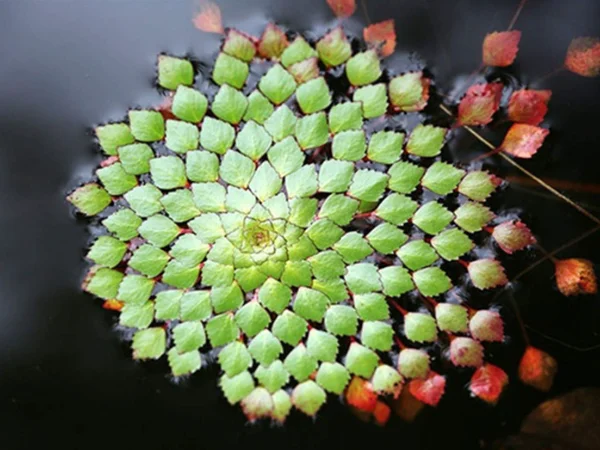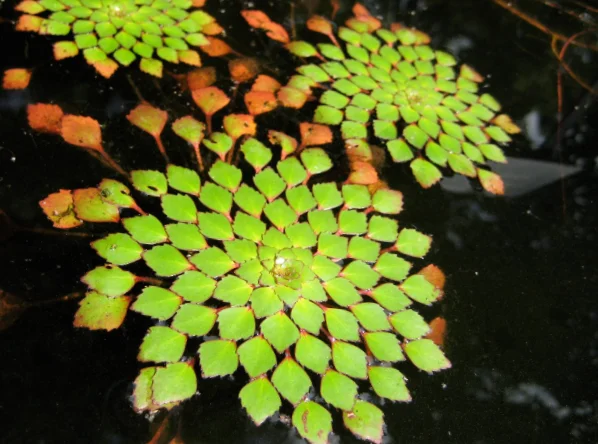Ludwigia Sedioides, commonly known as the mosaic plant, is a fascinating aquatic perennial native to South American countries like Venezuela, Panama, Colombia, and Brazil. This plant is visually stunning and serves various functional roles in an aquarium or pond setting. Before diving into the nitty-gritty of caring for this plant, let’s explore its unique features and why it’s a must-have for aquatic plant enthusiasts.

What is Ludwigia Sedioides?
Ludwigia Sedioides, also known as the mosaic flower or false loosestrife, is an emergent aquatic perennial. It’s a member of the Onagraceae family and is characterized by its beautiful diamond-shaped leaves display an intricate mosaic color pattern in red, green, and brown hues.
The plant thrives in warm, humid climates and is commonly found in swamps, along river banks, and other shallow freshwater areas in parts of South America. In the wild, Ludwigia Sedioides grows both as a submerged aquatic plant and as an emergent, with its foliage extending above the water’s surface. The emergent growth form displays the most intense leaf coloration.
Some key identifying features of this plant are:
- Diamond-shaped leaves with striking color variation
- Stems that can reach 12-18 inches in height
- Small yellow flowers with four petals
The visually stunning foliage is the main draw of Ludwigia Sedioides for aquarium hobbyists. The unique colors and patterns create an eye-catching display.
Is Ludwigia Sedioides a Floating Plant?
Yes, Ludwigia Sedioides is classified as a floating plant. An aquarium usually grows emersed, with the lower portion of the stem submerged while the upper leaves float on the water’s surface. The floating rosettes provide extensive coverage and shade.
One of the key benefits of Ludwigia Sedioides’ floating growth habit is that it enables the plant to absorb nutrients and pollutants from the water column. The floaters extract nitrogen, ammonia, nitrates, and other excess dissolved organic compounds. This helps improve overall water quality.

The broad floating leaves also help diffuse light and provide shaded areas in the tank. This can help control algae growth. The extensive floating foliage also offers protection and hiding spots for shy fish species.
The floating growth pattern makes Ludwigia Sedioides an excellent choice for natural aquariums and paludariums aiming to recreate biotope-accurate conditions.
Caring for Ludwigia Sedioides in an Aquarium
Caring for Ludwigia Sedioides is relatively straightforward, but there are some key needs to be aware of to keep it happy and vibrant in an aquarium environment.

Water Conditions
- Temperature: Ludwigia Sedioides thrives in warm water between 70-82°F. Cooler temperatures below 68°F can cause growth to slow or stall.
- pH: This plant does well in slightly acidic to neutral pH ranging from 5.5 to 7.0. Avoid keeping it in very alkaline conditions above pH 7.5.
- Hardness: Ludwigia Sedioides tolerates a wide range of water hardness levels. Still, optimal growth occurs in moderately soft to moderately hard water within 4-8 KH.
- Lighting: Bright lighting between moderate to high intensity promotes the best coloration and plant growth. Low light will result in pale, elongated stems.
Tank Parameters
- Size: A minimum tank size of 10 gallons is recommended, but Ludwigia Sedioides can be kept in nano aquariums as small as 5 gallons. Large colony growth requires at least a 20-gallon tank.
- Substrate: This plant grows well in most substrates including gravel, sand, soil, and aquarium dirt. Using root tabs will provide added nutrients.
- CO2: While not essential, injecting CO2 will significantly boost growth speed and maximize color intensity. Consistent CO2 levels around 5-15 ppm are ideal.
Maintenance
- Pruning: Regularly prune back overly long stems to encourage bushier growth. Removing faded or damaged foliage also improves overall plant health.
- Nutrients: Use a comprehensive fertilizer to provide necessary macros and micros. Alternatively, thrive with just fish waste in established tanks.
- Algae Control: Maintain stable CO2 levels and use algae eaters like shrimp or snails to keep leaves clean for optimal photosynthesis.
Is Ludwigia Sedioides Invasive?
Ludwigia Sedioides can be classified as an invasive aquatic species if introduced into natural ecosystems outside its native range. It’s growth habit allows it to spread and colonize new areas quickly.
In tropical and subtropical environments, Ludwigia Sedioides can become a problematic invasive species by outcompeting native plants, degrading water quality, and negatively impacting wildlife habitats if left uncontrolled.

For this reason, it’s recommended not to dispose of Ludwigia Sedioides plants or fragments into outdoor ponds, lakes or other waterways where it could take hold. This plant is best maintained in contained aquarium environments only.
Use caution and check your regional restrictions and regulations before obtaining Ludwigia Sedioides to ensure it’s permitted and legal to own in your area. Never release it into the wild.
Does Ludwigia Sedioides Need CO2?
While CO2 injection is unnecessary for Ludwigia Sedioides, providing dissolved CO2 significantly benefits growth. Adding carbon dioxide can allow this plant to thrive and reach its maximum potential coloration and vitality.
In lower tech setups without CO2 supplementation, Ludwigia Sedioides will grow taller and lankier with smaller leaves. Growth rate is also slowed. However, with the addition of CO2, the plant will display shorter internodes, much more compact growth, and larger, more intensely colored leaves.
Having 30-40ppm of dissolved CO2 and adequate lighting allow Ludwigia Sedioides to flourish. The CO2 also boosts photosynthetic processes, enhancing the foliage’s red hues.
For optimal results, using a pressurized CO2 system with a drop checker to monitor levels is recommended. However, CO2 from DIY yeast mixtures can also be utilized.
Even just slightly elevating CO2 compared to atmospheric levels can make a noticeable difference in the vibrancy of this stunning freshwater plant.
Aquarium Size and Propagation
- Tank Size: Ludwigia Sedioides can be housed in nano aquariums as small as 5 gallons. But it thrives with room to spread out in larger setups of 10+ gallons. This allows for larger colony growth.
- Height: Ludwigia Sedioides can reach up to 16 inches tall under ideal conditions. Maintain shorter height with routine trimming.
- Growth Rate: This plant displays a fast growth rate by stem propagation when provided with sufficient lighting and nutrients.
- Propagation: Ludwigia Sedioides propagates through stem cuttings. Simply cut a stem below a leaf node and re-plant the top portion to grow a new plant. Remove lower leaves.
- Maintenance: Regular pruning encourages bushier growth. Discard any floated away stems to avoid spreading through the aquascape.
Providing at least 12 inches of clearance below the light allows Ludwigia Sedioides space to reach its maximum potential size. Use pruning to maintain the desired height and fullness.
Price and Where to Buy
Ludwigia Sedioides is reasonably priced and available from most major online aquatic plant retailers. Expect to pay $5-10 for a starter portion with 3-5 stems. Here are some purchasing options:
- Buceplant.com: $5.99 per pot
- AquariumPlantsFactory.com: $7.99 for 5 stems
- AquaHuna.com: $6.99 for 3 stems
- LiveAquaria.com: $10.95 for 5 stems
Look for healthy green stems with colorful red leaves when shopping for this plant. Avoid any plants with excessive algae, damage, or signs of decay.
Larger quantities can be found on sites like eBay and Etsy, often at discounted prices compared to small portions. Purchasing tissue cultures can be another way to get a lot of growth for lower cost.
Benefits of Ludwigia Sedioides in Aquariums
Incorporating Ludwigia Sedioides provides multiple benefits beyond just visual appeal thanks to its functional properties:
- Effective nutrient absorption from the water column which improves water quality
- Provides shade which helps control algae growth
- Oxygenates the tank water through photosynthesis
- Offers protection, shelter and ambush spots for shy fish
- Can provide a resting spot for aquatic frogs and insects
- Fast growth allows it to fill in the background of new aquascapes rapidly
- Vibrant colors add striking contrast and interest to planted layouts
Ludwigia Sedioides offers both form and function. It’s ability to absorb excess nutrients effectively makes it a popular choice for helping new tanks establish balance and keep parameters in check. The vivid foliage also livens up any freshwater aquarium.
Additional Variants and Related Plants
Beyond the common Ludwigia Sedioides there are some other color variations and closely related Ludwigia species worth mentioning:
- Ludwigia Sedioides ‘Rubin’ – This variety has foliage that is a more intense blood-red color than the standard plant. It demands high light and CO2 to achieve the richest hues.
- Ludwigia Arcuata – Very similar looking to Ludwigia Sedioides but with slightly more round leaves. The color pattern is still a vibrant mosaic of reds, greens, and browns.
- Ludwigia Repens ‘Rubin’ – While not as brightly colored as L. Sedioides, this plant displays attractive ruby red foliage under high light. Much easier to care for.
- Ludwigia Inclinata ‘Tornado’ – Dramatic spiraling red and green leaves make this Ludwigia variety stand out. It requires CO2 injection and trimming to look its best.
- Ludwigia Palustris – The broad leaves emerge with a nice reddish tint before transitioning to green as they mature. Very fast growing and easy to propagate.
There are countless other great Ludwigia species, but these share similarities in color and growth habit to the striking mosaic plant. All make excellent choices to add vivid color to planted tank aquascapes in their own right.
Aquascaping Ideas with Ludwigia Sedioides
Ludwigia Sedioides offers aquascapers a versatile option to incorporate into many different underwater layout styles. Here are some potential ways to utilize it:
- As a focal point – Use Ludwigia Sedioides as a centerpiece surrounded by lower growing carpet plants and hardscape materials. Let it be a star and highlight its colors.
- Contrasting heights – Plant tall bushy stems of Ludwigia behind shorter species to create depth and layers.
- Colored accent – Use smaller groupings of stems amongst green plants to provide a pop of red color.
- Background – Fill the back vertical space by planting rows of Ludwigia behind hardscape and other plants. Allows it to spread.
- Floating island – Let clusters of stems float at the surface surrounded by open water to mimic its natural habitat.
- Paludarium emergent growth – Allow leaves to extend above waterline to transition to terrestrial areas in ripariums and paludariums.
Take inspiration from biotope aquascapes that mimic its native environment. Ludwigia Sedioides can create a convincing slice of the Amazon with driftwood, river stones, and floating plants.
Conclusion
There’s no denying that Ludwigia Sedioides makes a statement. The beautifully patterned foliage provides visual interest that few other aquatic plants can match. This, combined with its beneficial nutrient absorption capabilities and ease of care, makes it highly recommended for planted tank enthusiasts looking to add new colors and textures.
While Ludwigia Sedioides has specific care requirements regarding lighting, CO2 injection, nutrients, and water parameters, it’s still relatively undemanding once its needs are met. The growth habit also makes propagation simple through stem cuttings. Overall, the vivid colors and rapid growth make this a rewarding and eye-catching aquatic plant suitable for aquarists of all levels to appreciate.